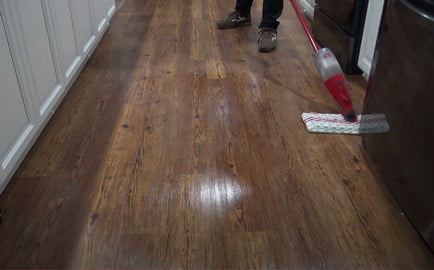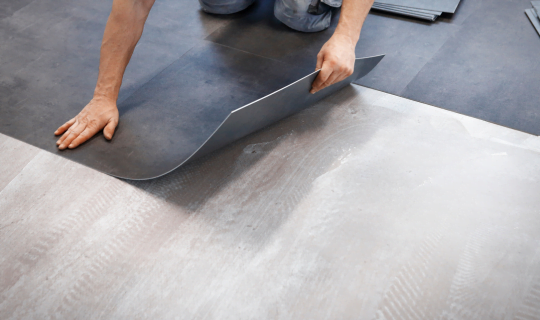How To Fix Vinyl Plank Flooring Separating
Have you noticed your vinyl plank flooring separating? This can be a frustrating and unsightly issue, but luckily it can…
Have you noticed your vinyl plank flooring separating? This can be a frustrating and unsightly issue, but luckily it can be fixed.
In this article, we will provide you with step-by-step instructions on how to fix your vinyl plank flooring separation.
First, it’s important to understand the cause of the separation. Sometimes the problem can be due to a subfloor issue, while other times it may be a result of improper installation or simply due to wear and tear over time.
Identifying the cause will help you determine the best course of action to fix the problem. So, let’s dive in and get to the root of the issue.
Identifying the Cause of Separation
Looking for the reason behind the gaps in your vinyl flooring? Let’s start by identifying the cause of separation.
One of the most common reasons for vinyl plank flooring separating is moisture damage. When moisture seeps into the subfloor, it can cause the planks to expand and contract, leading to gaps between them. This can happen due to a variety of reasons, such as a leaky roof, plumbing issues, or high humidity levels.
Another reason for vinyl plank flooring separating is improper installation. If the planks are not installed correctly, they can shift and move over time, leading to gaps between them. This can happen if the subfloor is not properly prepared, or if the planks are not acclimated to the room’s temperature and humidity levels before installation. Additionally, if the planks are not locked together tightly, they can separate over time.
To identify the cause of separation in your vinyl plank flooring, you should inspect the affected area closely. Look for signs of moisture damage, such as water stains or mold growth. Check the subfloor for any signs of damage or unevenness.
If you suspect that the issue is due to improper installation, look for gaps between the planks or any signs of movement. Once you have identified the cause of separation, you can take the necessary steps to fix the issue and prevent it from happening again.
Removing and Reinstalling Affected Planks
If you’re struggling with gaps in your vinyl flooring, don’t worry – there’s a simple solution: remove and reinstall the affected pieces.
The first step is to identify which planks are causing the separation. Once you’ve done that, you can start the process of removing and replacing them. If the planks are damaged, you’ll need to replace them with new ones.
Before you begin, make sure you have the proper tools for removing the planks. You’ll need a utility knife, a pry bar, and a hammer.
Begin by cutting the damaged plank into small pieces using the utility knife. This will make it easier to remove. Next, use the pry bar to gently lift the plank up and out of the floor. Be careful not to damage the surrounding planks.
Once you’ve removed the damaged plank, it’s time to install the new one. Start by cleaning the area where the old plank was removed. Then, use a tongue and groove adhesive to secure the new plank in place.
Make sure it’s level with the surrounding planks and allow the adhesive to dry completely before walking on the floor. With a little patience and the right tools, you can easily fix any gaps in your vinyl plank flooring.
Addressing Subfloor Issues
To tackle subfloor issues, it’s crucial to assess the root cause of the problem and take necessary steps to ensure a stable base for your new vinyl plank flooring.
One possible solution is patching the subfloor. If you notice any cracks or holes in the subfloor, it’s best to fill them with a suitable patching compound. This helps to create a smooth and even surface for your new flooring to rest on. It’s important to allow the patching compound to dry completely before installing the vinyl planks.
Another solution to subfloor issues is strengthening it. This is especially important if you notice any sagging or warping in the subfloor. To strengthen the subfloor, you can add additional support beams or joists. This helps to distribute the weight of the flooring evenly across the subfloor, preventing any future separation or buckling. It’s important to consult a professional if you’re unsure about the structural integrity of your subfloor.
In addition to patching and strengthening, it’s important to ensure the subfloor is clean and free of debris before installing the new vinyl planks. Any dirt or debris can cause unevenness, leading to separation or buckling.
By addressing the subfloor issues before installing new vinyl planks, you’ll ensure a stable and long-lasting flooring solution for your home.
Using Adhesive to Reattach Planks
By utilizing adhesive to reattach the planks, you can ensure a secure and stable foundation for your home’s flooring.
There are several adhesive types available, such as pressure-sensitive, contact, and resin-based. It’s essential to choose the right adhesive for your type of vinyl plank flooring. You can consult with a professional or follow the manufacturer’s recommendations to ensure you have the correct adhesive.
Proper application techniques are crucial when using adhesive to reattach vinyl plank flooring. First, clean the area thoroughly to ensure no debris or dirt is present. Next, apply the adhesive to the underside of the plank by using a notched trowel. Then, press down firmly on the plank, ensuring it’s in the correct position. Repeat the process for each plank that needs reattaching.
Allow time for the adhesive to dry before walking on the floor.
Here are three reasons why using adhesive to reattach vinyl plank flooring is a wise decision. Firstly, it’s a cost-effective solution to repairing your floor. Secondly, it’s easy to apply, and the results are long-lasting. Finally, using adhesive to reattach your planks can prevent further damage to your flooring, ensuring that your home remains beautiful and functional for years to come.
Preventing Separation in the Future
You can avoid future separation in your flooring by taking a few preventative measures. Firstly, proper cleaning is essential to ensure that the adhesive used to hold the planks in place sticks properly. Dirt and debris can interfere with the adhesive, leading to separation. Therefore, it’s important to sweep or vacuum the floor before cleaning it with a suitable cleaner. Avoid using harsh chemicals or abrasive tools that can damage the floor.
Secondly, floor preparation is crucial to prevent separation. Before installing the vinyl planks, make sure that the subfloor is clean, level, and free from any debris. Any bumps or dips in the subfloor can cause the planks to separate.
It’s also important to let the planks acclimate to the room’s temperature and humidity before installation. Failure to do so can cause the planks to expand or contract, leading to separation.
Lastly, it’s important to avoid exposing the vinyl plank flooring to extreme temperatures or moisture. High humidity levels can cause the planks to expand, while low humidity levels can cause them to shrink. Also, avoid placing heavy furniture or appliances directly on the flooring. Use furniture pads or coasters to distribute the weight evenly and prevent dents or scratches.
By following these preventative measures, you can ensure that your vinyl plank flooring stays intact and looking great for years to come.
Conclusion
Overall, fixing vinyl plank flooring separation is a task that requires some effort and attention to detail. It’s important to identify the root cause of the separation, whether it’s an issue with the subfloor or simply a faulty installation.
From there, removing and reinstalling the affected planks or using adhesive to reattach them may be necessary. It’s also important to address any underlying subfloor issues to ensure a long-lasting fix.
By following the steps outlined in this article, you should be able to successfully repair any separated vinyl plank flooring. However, it’s important to keep in mind that prevention is key when it comes to avoiding future separation.
Ensuring a proper subfloor installation and following manufacturer guidelines for installation and maintenance can go a long way in avoiding any future issues. With proper care and attention, your vinyl plank flooring should stay secure and beautiful for years to come.


